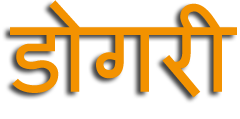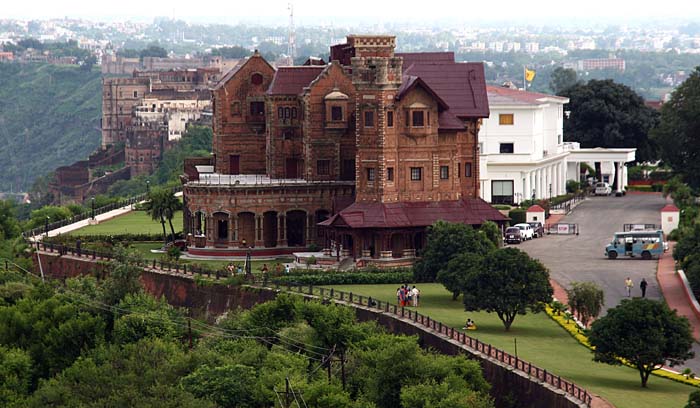Dogri has a very old tradition of oral literature and there exists a rich treasure, both in content and form, of folk songs, folk tales, riddles, proverbs, idioms, etc., which represent various aspects of Dogra life. However as far as written literature is concerned, it is rather a recent phenomenon.
The region covering the area of J and K State lying between rivers Chenab and Ravi, the adjoining area of Himachal, districts of Gurdaspur and Hoshiarpur, and areas of Sialkot, Zaffarwal and Shakargarh of Pakistan, is mainly the Dogri speaking region. As far as the antiquity of usage of Dogri language is concerned, Dr. J. Voghel has reported a stone inscription in Takri Script at ‘Salhi’ on ‘Sechu Nallah’ dated 1160 A.D. Amir Khusro (1253-1325 A.D.), in his Masnavi Nuh-Sipihir, mentions Dogri in the list of prominent Indian languages. There are numerous later references of copper plates, chronicles of Raja’s agreements, letters and title deeds written in Dogri in Takri script which establish the common usage of this language in early times.
Dogri has a very old tradition of oral literature and there exists a rich treasure, both in content and form, of folk songs, folk tales, riddles, proverbs, idioms, etc., which represent various aspects of Dogra life. However as far as written literature is concerned, it is rather a recent phenomenon. Sporadic attempts made in written literature in earlier times are evidenced by a few verses of poets like Manak Chand (Born 1565 A.D.), Rani Vikram Singh (1662-1675), Ghambir Chand (Born 1690) and Kanshi Ram (1743-1836). Deserving special mention is a song ‘Killiya Battana Chhuri Ditta…’ and two more complete poems by Devi Ditta (Dattu) as fine examples of literary masterpieces. Dattu, a cotemporary of Raja Ranjit Dev (1735-1750), was an established poet of Braj bhasha. Among others, Pt. Ganga Ram’s (1777-1858 A.D.) famous poem ‘Kandi Da Bassana’ presents an authentic picture of hard life of Kandhi. Printing books in Dogri was initiated during the reign of Maharaja Ranbir Singh (1857-1885) when special efforts were made for promotion and development of Dogri language. Dogri was the court language along with Persian, an improved version of Dogri (Takri) script was prepared, new books in Dogri were got written and some important works from other languages were got translated into Dogri. The original works included books concerning law, medicine, a primer, Vyavahar Geeta and army drill, where as major works of translation are ‘Leelavati’, a treatise of Mathematics and Shrimad Bhagwat Geeta .
However with the death of Maharaja Ranbir Singh, Dogri went into a phase of neglect and decline. The only achievements worth mentioning during this dark period were famous poem ‘Channa Di Chanani Channa Kane’ by Ram Dhan, publications of Dogri Bhajanmala by Har Datt in 1930 and tranaslation of Bhagwat Geeta by Prof. Gouri Shankar in 1934.
In fact it was with the formation of Dogri Sanstha in 1944, that a golden era of unprecedented and phenomenal growth of Dogri dawned. Long neglect and official indifference towards Dogri had created a sense of inferiority among Dogras regarding their mother tongue. Dogri was considered to be a language of uncouth and uneducated. Educated and high ranking Dogras shirked from speaking Dogri in public. It was under such conditions that a bunch of young enthusiastic writers laid down the foundation of Dogri Sanstha with the aim of instilling a sense of love and pride for their mother tongue among Dogras. The founders of Dogri Sanstha were Ram Nath Shastri, Dinu Bhai Pant, D.C. Prashant, B.P. Sathe, Master Sansar Chand Baru and N.D. Misra. After that the history of Dogri Sanstha became synonymous with the history of Dogri Literature. The founders of Sanstha must have been enthused as a result of the immense popularity of Dogri poem ‘Shehr Pehlo Pehl ge…’ by Dinu Bhai Pant published in 1944.
During the decade of nineteen- forties and fifties vigorous efforts were made to create literature and explore avenues to popularize it among masses. In addition to literary get-to-gathers of Dogri writers on regular basis, number of Mushairas and Kavi Sammelans were held and new plays were written and staged. In 1946 two booklets of poetry ‘Veer Gulab’ and ‘Mangoo Di Chhabeel’ written by Dinu Bhai Pant were published. In 1947 the first collection of Dogri Short Stories ‘Pehla Phull’ by Bhagwat Prasad Sathe was published, followed by publication of first anthology of Dogri poems ‘Jaggo Duggar’ in 1949 by Dogri Sanstha, which contained poems by Har Datt, Dinu Bhai Pant, Ram Nath Shastri, Krishan Smailpuri, Parmanand Almast, Yash Sharma and Ved Pal ‘Deep’. In the decade of nineteen- fifties Dogri Sanstha brought out five collections of poems, four collections of short stories, two play-lets and four books of Vedanta. A number of organizations, aimed at working for Dogri, came into being like, Dogra Mandal, Dogra Himachal Sanskriti Sangam etc. J and K Academy of Art, Culture and Languages was set up in 1958 which also started to work for growth and development of all regional languages, including Dogri. First number of Dogri literary magazine ‘Nami Chetna’ was brought out by Dogra Mandal Delhi in 1953, the publication of which on regular quarterly basis was later taken over by Dogri Sanstha. The new prominent poets who emerged on the scene included, Kehri Singh Madhukar, Padma, Tara Smailpuri, Shambhu Nath, Raghunath Singh Sambyal, Ved Rahi etc. The short story writers whose books were published in fifties were Lalita Mehta, Ved Rahi, Narinder Khajuria, Madan Mohan Sharma, and Ram Kumar Abrol.
Dogri Sanstha staged a play ‘Baba Jitto’ at Tikkri in 1948, which was accompanied by the first ever exhibition of Dogra Pahari Miniature paintings. Later, in 1950, an exhibition of paintings on a larger scale was held in Jammu, followed by another exhibition at national level at Delhi in 1954. ‘Naman Garan’ published in fifties by Dogri Sanstha and written jointly by Ram Nath Shastri, Dinu Bhai Pant and Ram Kumar Abrol was the first printed play in Dogri.
The most significant achievement of decade of sixties was the recognition of Dogri as independent literary language by Sahitya Akademi, Delhi in 1969. In this decade about hundred books were published which included three novels written simultaneously by Madan Mohan Sharma, Narinder Khajuria and Ved Rahi and published in 1960, eight selections of Essays and twenty one translations of classical literary works of other languages. A book of Dogri proverbs in 1962 and another of Dogri idioms in 1966 by Tara Smailpuri were published. A large number of new writers joined in, out of which more than hundred were poets. Dogri made in- roads into educational system with the introduction of examination of ‘Tilak’ in 1964 and higher level examinations of ‘Parveen’ and Shiromani’ in 1967 and 1969 respectively. The J&K Academy started publication, in volumes, of Dogri folk songs and folk tales, the number of which reached 18 and 15 respectively by 1992. In 1964 J&K Academy started publication of its six monthly journal ‘Sheeraza’ in Dogri. Dogri Sanstha organized first Dogri Writers Conference in 1966. Thus by beginning of seventies Dogri literature had gone through a phase of all round development covering almost all genres.
In 1970 Sahitya Akademi started the annual awards to best book of Dogri and Narinder Khajuria was the first to receive this honour, though posthumously. Two more All India Dogri Writers Conferences were held in seventies. The work on Dogri-Hindi and Dogri-Dogri dictionaries was initiated by J&K Academy. Dogri Research Centre was established in Jammu University in 1975. The number of writers and frequency of publications increased many fold. Young talented writers added new dimensions to Dogri literature, which marked seventies as the decade of modern sensibility.
During Nineteen Eighties two All India Writers Conferences were held. Five volumes of Dogri-Dogri dictionary and concise Dogri-Hindi dictionary were published. A major achievement of this decade has been inclusion of Dogri at various levels of education. Dogri subject was introduced at Secondary (Classes 9th and 10th) and Higher Secondary (Classes 11th & 12th) levels of School and at Undergraduate level of Colleges in 1983, 1989 and 1986 respectively. The Post Graduate Department of Dogri was established in 1983 in University of Jammu. First autobiography in Dogri ‘Pagdandian’ by Vishwa Nath Khajuria was published in 1985. Play ‘Baba Jitto’ written by Ram Nath Shastri and directed by Balwant Thakur was staged in 1986, of which more than hundred shows have been held all over India.
In the year 1986 Dogri subject was introduced in the Kashmir Administrative Services examination. During the last decade of 20th and first decade of 21st century, there has been a large number of Conferences, Seminars and Symposia organized by Dogri Sanstha, J&K Academy, P.G. Department of Dogri, University of Jammu and Sahitya Akademi, New Delhi. Many workshops on theatre, standardization of spellings and on translations have been held. Special conferences on women writings in Dogri have been organized by Dogri Sanstha in 1991, 1992 and 1993.
In the year 2003, Dogri achieved another milestone. It got its rightful place, with other major languages in VIII Schedule of Indian Constitution. As a consequence of this Dogri subject has been introduced in the IAS examination, National Book Trust initiated the process of translation and publication of Dogri works. National Translation Mission has embarked upon translating knowledge books pertaining to Science, Technology and Humanities into Dogri, Central Institute of Indian Languages is preparing Carpora of Dogri and has already produced and published Dogri Style Manual in collaboration with Dogri Sanstha and Northern Regional Language Centre, Patiala has started Dogri Learning Course for Non-Natives. Further, Department of Information Technology, Govt. of India, through C-DAC, has, with the assistance of scholars and experts of Dogri,prepared nine Software programs and tools in Dogri, containing more that 1.5 Lac statements and strings, made available to general public, free of cost on internet. With the help of these programmes any Dogri knowing person can use computers and internet for almost all IT facilities. As on-line Dogri-English dictionary has also been prepared and made available.
In this background a large number of enthusiastic writers is busy creating Dogri literature in various genres. There is a spurt of functions held to release Dogri Books. But the matter which is of grave concern and worry is the dwindling number of people who speak Dogri. What to talk of reading Dogri books, those who claim to love Dogri can not even name four books. Unless Dogras give due respect to their mother tongue in their homes, by speaking Dogri to their children and by having at least a couple of Dogri books and magazines in their households, the future of Dogri does not appear to be very promising.










Very good information indeed. You are right, many Dogras prefer to speak Punjabi and Hindi in their homes. When the child starts speaking, the now-a-days parents try to confuse the child by asking:show me your teeth? nosoo kahan hai? etc. Whereas he/she is discouraged to learn Dogri. How the child can pick up multiple languages? Unless we drop this inferiority complex, Dogri can not develop.
Neglect of Dogri is an established fact but it is not as alarming as has been thought of. Though Jammu being cosmopolitan in nature may an exception yet I find all Dogra families and their children still living Dogri language; the same cant be expected of migrants. Yes the younger generation have not been brought closer in Jammu city but the situation is different in villages and other cities. Nevertheless, a concerted effort is required to save this language from deterioration, quantitatively and qualitatively as well.
great article !
Very good..work.sir.i came across this article while trying to find the peom sher pehlo pehl gaye. But was unable to find it.
The poetry..of dinu bhai pant..need to be uploaded..so our generation can have a easy access to it.